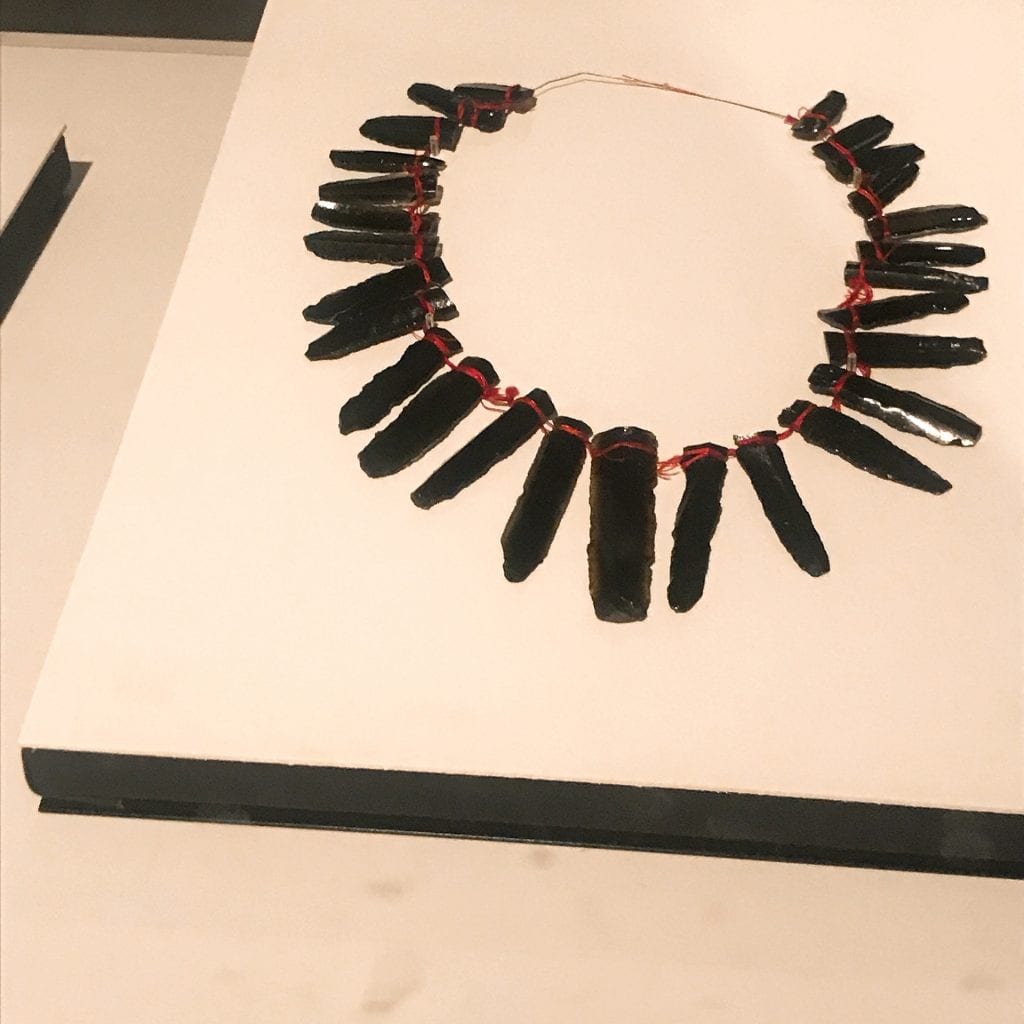object 1
- Designer(s) / Creator: Frida Kahlo
- Name of the Artifact: Necklace of Obsidian Blades
- Origin: Where it was made: Mexico
- Season/Year: before 1492
- Function – it is designed for adornment.
- Fabrication –obsidian, cotton, and metal
- Form – where did this form come from – how did it evolve?
This name of the piece is called necklace of obsidian blade and created by Frida Kahlo. It was made in Mexico during 1492. by looking at this piece, I could notice sharp black jam stones. This is necklace that can be worn. Frida wore this necklace when she attended the ritual activity. The necklace was made by extremely sharp edges stones, which used by the Maya and other early Mesoamerican culture for weapons. When I first saw the rough edge of necklace, it looks like weapon rather than jewelry. I thought it doesn’t have purpose of self- adornment that jewelry originally conveys in contemporary time. The piece just expresses Mexico’s indigenous history. From out of research, I found the necklace reflected Mexico culture and it embraced her own culture in her daily life.
https://www.wallpaper.com/watches-and-jewellery/frida-kahlo-vanda-exhibition-london
object 2
- Designer(s) / Creator: Frida Kahlo
- Name of the Artifact: Plaster Corset
- Origin: Where it was made: Mexico
- Season/Year: circa 1950
- Function – it is designed for medical purpose.
- Fabrication – plaster, medical bandages, paint, and mixed media
- Form – wwqhere did this form come from – how did it evolve?
It is plaster corset created by Frida Kahlo. It was created in Mexico in 1950. When I first look at it, image of hospital and patient came to mind because it was made of bandage. And the form and shape of it looks like a plaster cast when back is hurt. It is of course wearable, the corset was designed as intention of ventilating and representing absence of a fetus. Moreover, the object transformed notion of beauty in contemporary time since people in these days usually hide their negative features rather than emphasizing or revealing. Furthermore, it expresses Frida Kahlo’ personal life as she turned her pain into art, not concealing her shortcoming. I was impressive that Frida expressed her sadness as a woman who could not have a fetus by sublimating it with art. For independent research, I learned that she left her bedridden for most of her rest life and left her infertile.
https://www.artsy.net/article/artsy-editorial-stories-7-objects-made-frida-kahlos-iconic
object3
- Designer(s) / Creator: Frida Kahlo
- Name of the Artifact: Huipil
- Origin: Where it was made: Mexico
- Season/Year: before 1954
- Function – it is designed for clothing
- Fabrication – cotton, rayon
- Form – wwqhere did this form come from – how did it evolve?
It is huipil worn by Frida Kahlo. It was created in Mexico in 1954. Kahlo was dressed in a huipil on her deathbed. It is different than one of her colorful Tehuana outfits. It was made from plain handwoven cloth in the mountain village of Yalàlag. The huipil was capacious enough to comfortably cover Kahlo’s orthopedic corsets. First impression of the tunic was quite shocking because I thought it would be a just formal dress that she had worn in daily life, but it was dress when she was dead. So, I could realize she was feminine. This is because in contemporary time, when a person is dead, regardless of gender, person wears top and white pants rather than dress style. Also, I really like to research about the tunic, but there are no any sites that have information about it.
Part 2:
Since I didn’t take a picture of the worksheet paper, I couldn’t remember exact creators and origin, materials, date of these two artifacts. But I can remember that I compared the hair piece and the photograph of Frida Kahlo because of similar appearance of the two artifacts. Both hair pieces were worn by Frida. From these two artifacts, I could realize that Frida prefered these kinds of flower decoration of hair piece because the artifacts have associated and analogous style with similar kind of flowers and colors.
Part 3: This is a reflection your your experience.
After I visited the exhibition, I learned a lot of thing about the Frida Kahlo. I didn’t know about her. I just thought she was famous because of her unique painting technique with trademark of dark eyebrows. I was not aware of backgrounds and histories of her at all. Therefore, I was not interesting to visit her exhibition in Brooklyn. However, it was shocking to know about her life story and her works. She had painful and severe accident that made her life lost with bad health condition. Nevertheless, she turned her suffering memories into enjoyable art form. I believed it would be hard to use illness as an aesthetic aspect. I really admired her works. After the exhibition, I was able to understand why she is a one of the worldwide popular artists. Through her works, I realized that rather than hiding faults or shortcoming, revealing what I reluctant can be a new way to express myself.







